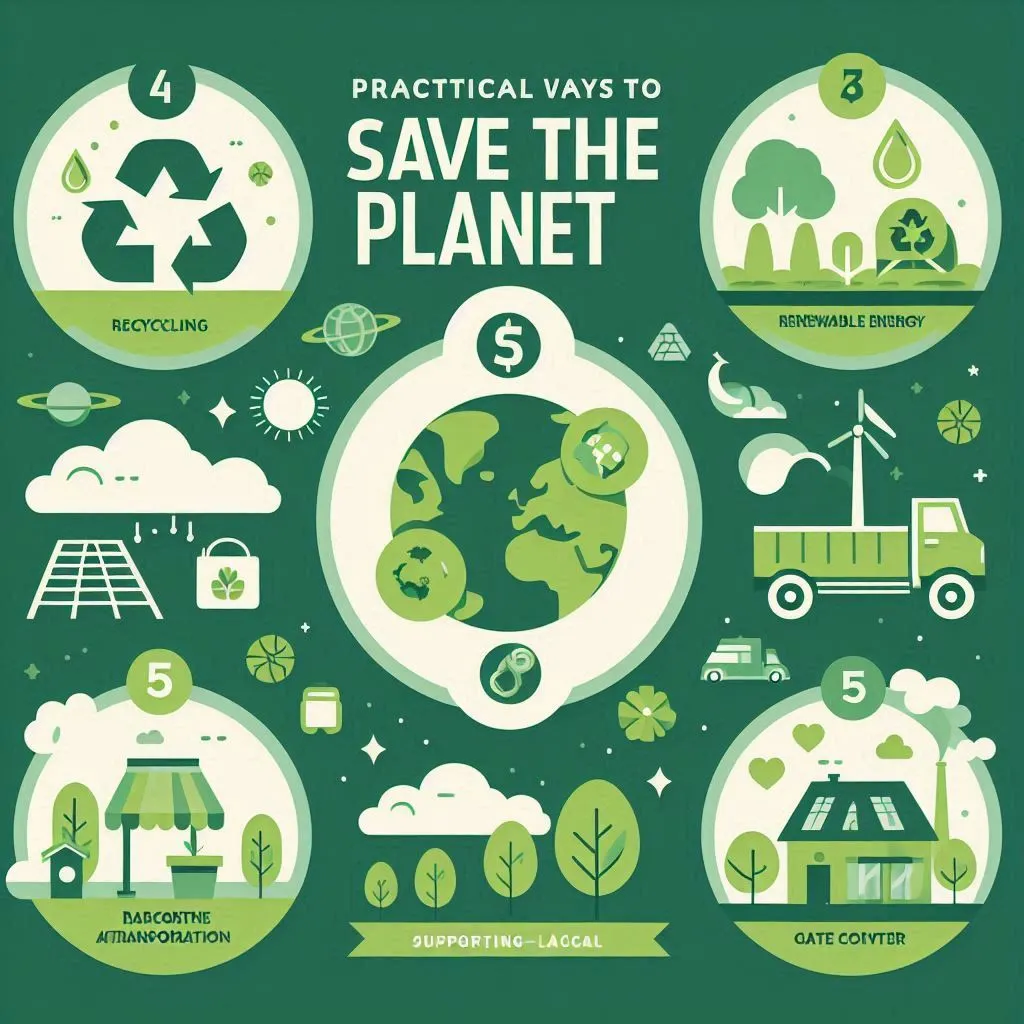5 Ways to Save the Planet: Practical Steps for a Greener Future
In today’s world, protecting our planet has become more than just a call to action—it’s a personal responsibility that affects our daily lives, health, and future generations. Having grown up in a family that prioritized environmental stewardship, I’ve seen firsthand how small lifestyle changes can lead to impactful results. From participating in community cleanups to reducing our household waste, my journey toward sustainability has been eye-opening, and I’m here to share actionable insights.
This article delves into five proven ways to make a positive environmental impact, backed by real-world examples, statistics, and expert opinions. Each section provides not only easy-to-implement advice but also a comparison of different approaches to find what fits your lifestyle best.

1. Reduce, Reuse, Recycle: The Three R's of Waste Management
The concept of "Reduce, Reuse, Recycle" has been around for decades, but it remains one of the most effective ways to lower waste output and lessen our environmental impact.
Reducing Waste
The most effective way to reduce waste is by cutting down on what we consume. According to the World Bank, global waste generation is expected to increase by 70% by 2050 unless urgent action is taken.
Reusing Items
Reusing products not only reduces waste but also decreases demand for manufacturing, which can significantly cut down greenhouse gas emissions. Instead of single-use plastics, try opting for reusable containers and bags.
Recycling Properly
Recycling helps conserve natural resources like water and minerals. However, it’s essential to follow local recycling guidelines to avoid contamination.
Expert Tip: "Recycling properly and reducing single-use products are foundational steps in waste management, yet they are often overlooked. A commitment to the Three R’s can make a measurable difference." - Dr. Anne Johnston, Environmental Scientist at Green Earth University
2. Embrace Renewable Energy
Switching to renewable energy sources, like solar and wind power, can reduce reliance on fossil fuels and decrease greenhouse gas emissions.
Solar Power
Solar panels are now more accessible than ever. In a study by the National Renewable Energy Laboratory (NREL), homeowners who switch to solar energy can reduce their carbon footprint by up to 80%.
Wind Energy
Wind farms, both onshore and offshore, have become popular alternatives for communities. Wind energy now supplies over 10% of the electricity demand in the U.S.
Comparative Advantage: While wind energy requires large-scale infrastructure, solar panels are a practical choice for individuals. Even a small solar installation on a home or apartment can make a significant difference.
Statistics: The International Energy Agency (IEA) found that renewable energy capacity grew by nearly 7% in 2022, a promising sign that global adoption is on the rise.
3. Choose Sustainable Transportation
Transportation is one of the largest sources of greenhouse gas emissions worldwide. Adopting sustainable travel options can lead to substantial environmental benefits.
Electric Vehicles (EVs)
EVs are now widely available and more affordable. Studies show that switching to an electric vehicle can reduce an individual’s carbon emissions by nearly half.
Public Transport
Taking public transportation instead of driving can cut emissions and reduce congestion. According to the American Public Transportation Association, public transport use saves around 37 million metric tons of carbon emissions annually.
Biking and Walking
For shorter distances, consider biking or walking. This choice not only cuts emissions but also improves personal health.
Case Study: In Copenhagen, Denmark, 62% of residents commute by bicycle, significantly reducing the city’s carbon footprint and setting an example for other urban areas to follow.

4. Support Eco-Friendly Products
Purchasing eco-friendly products sends a powerful message to manufacturers and helps reduce the environmental impact of production processes.
Organic and Sustainable Products
Organic farming practices avoid harmful chemicals, promoting soil health and biodiversity. Supporting brands that follow eco-friendly practices helps drive change.
Avoiding Fast Fashion
The fashion industry is one of the largest polluters, contributing to water pollution, waste, and high energy use. Choose sustainable clothing brands or thrifted items to minimize this impact.
Comparative Value: While sustainable products may be priced higher than conventional options, they often last longer, reducing the need for frequent replacements and contributing to a circular economy.
Quote from an Expert: "By prioritizing sustainability in our purchases, we push the industry toward greener practices. We have a vote in the marketplace, and every eco-friendly choice counts." - Sarah Lane, Founder of EcoConsumer Magazine
5. Practice Water Conservation
Water is a precious resource, and conserving it is crucial for sustainability. According to the United Nations, water scarcity affects over 2 billion people, highlighting the importance of responsible usage.
Fixing Leaks and Using Low-Flow Fixtures
Fixing household leaks can save thousands of gallons annually, while low-flow fixtures reduce water consumption by as much as 60%.
Efficient Gardening and Landscaping
Choosing drought-resistant plants and using rainwater collection systems help save water.
Comparative Benefits: While low-flow fixtures are effective in conserving water in homes, rainwater collection systems are ideal for areas with unpredictable water supply.
Statistic: The U.S. Environmental Protection Agency (EPA) estimates that by simply fixing leaks in homes, Americans could save over 90 billion gallons of water annually, enough to meet the annual water needs of 11 million homes.

Conclusion: Taking Small Steps Toward Big Change
Saving the planet doesn’t require grand gestures—small, consistent actions can create significant, lasting change. By integrating these five sustainable practices into daily life, each of us can contribute to a healthier, more resilient planet.
Remember, the journey to sustainability is continuous. Each eco-friendly decision helps reduce our carbon footprint, conserve natural resources, and foster a more sustainable future. Start today, and encourage others to join you in making the planet a cleaner, greener place for generations to come.
Actionable Insight: Choose one of the above practices to focus on this month and gradually expand your eco-friendly habits. Over time, these small changes will compound, helping you lead a greener, more sustainable life.